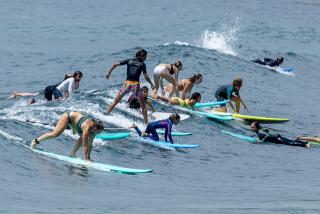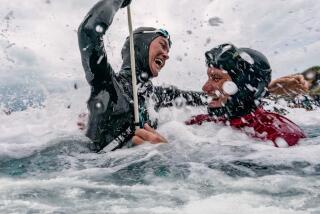Watertight Advice
- Share via
[2]Darren Douglass was well known in scuba circles as an accomplished diver, an expert at leading expeditions to the deep. On July 2, he took along his 14-year-old son when a group set out to explore a shipwreck off San Pedro.
But before day’s end, rescuers found father and son motionless on the ocean floor. There was speculation that a snagged anchor line and other problems--including a very deep dive--led to the drownings.
The tragedy underscores the need for even seasoned water sports enthusiasts to practice safety precautions, experts said. This is especially vital for vacation travelers venturing into unknown waters to swim, scuba dive or snorkel.
Drowning claimed more than 3,000 lives in the United States in 1993, the most recent year for which statistics are available, according to the National Safety Council. But the risk plummets when simple safety measures are observed.
Swimming should take place only in supervised, guarded areas and should be done with a partner, said Bill Richardson, president of the U.S. Lifesaving Assn., a Huntington Beach-based national organization of open water lifeguards who oversee all bodies of water except pools. The risk of drowning in open water, he said, is only “one in 14 million” on guarded beaches, according to USLA statistics.
Swimmers should also be careful not to overestimate their abilities. This is a common error. For example, it’s crucial even for good swimmers to avoid ocean rip currents--strong currents created by surf breaking into shallow water and then turning seaward. “Most ocean beaches with surf have rip current,” Richardson said, “and 85% of [U.S.] rescues involve rip currents.”
Ask a posted lifeguard about rip currents, experts suggested, and about surfing zones, which swimmers should also avoid.
Swimmers in trouble should wave their arms in the air, if possible, since that is the international sign of distress, said Brant Bass, of the San Diego Lifeguard Service, a city agency.
“Snorkeling should be done in calm water areas,” Richardson said. “Otherwise, you won’t find anything to look at.”
The same precautions recommended for swimming--such as staying within areas where lifeguards are posted--apply to snorkeling, Bass said.
Scuba divers should take instruction approved by a respected group such as the National Assn. of Underwater Instructors, Richardson said. He also recommends that travelers avoid brief, last-minute scuba courses given at vacation destinations.
Respecting dive depth limits is a must too. “Generally, there is no reason to go below 100 feet,” Richardson said. When divers go below 100 feet, Richardson said, the risks multiply.
While most lifeguard stations stock first-aid equipment, packing a few supplies is a good idea. Among suggested items: antibacterial cleansing agent, bandages, sunscreen, sunburn remedies, fresh water and paper cups for drinking water, as well as for rinsing sand from the eyes.
*
The Healthy Traveler appears the second and fourth week of every month.
More to Read
Sign up for Essential California
The most important California stories and recommendations in your inbox every morning.
You may occasionally receive promotional content from the Los Angeles Times.













